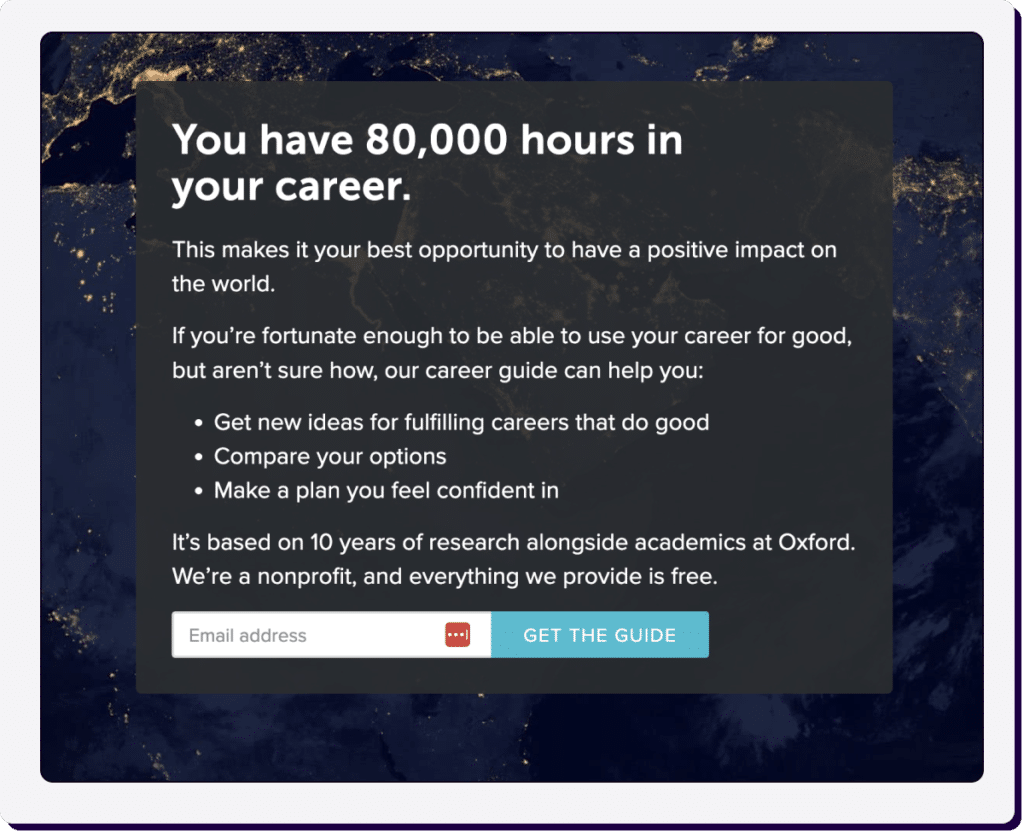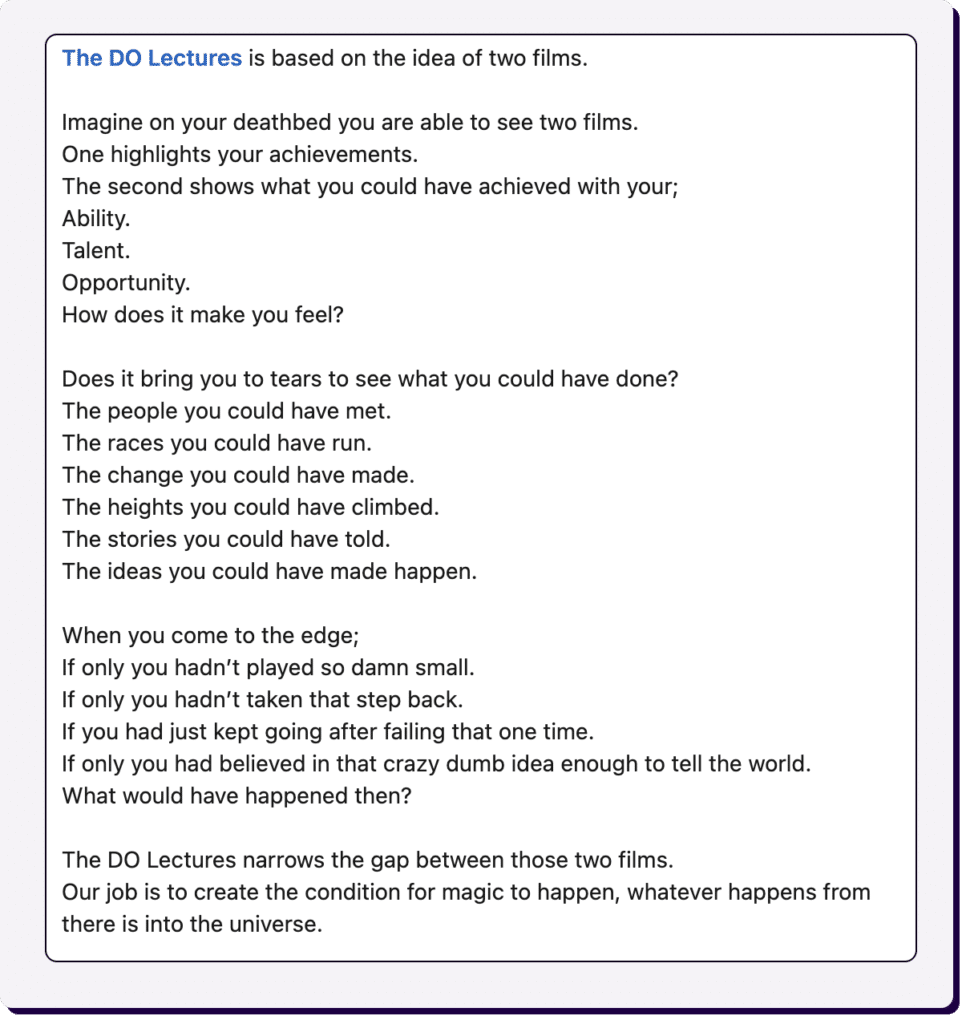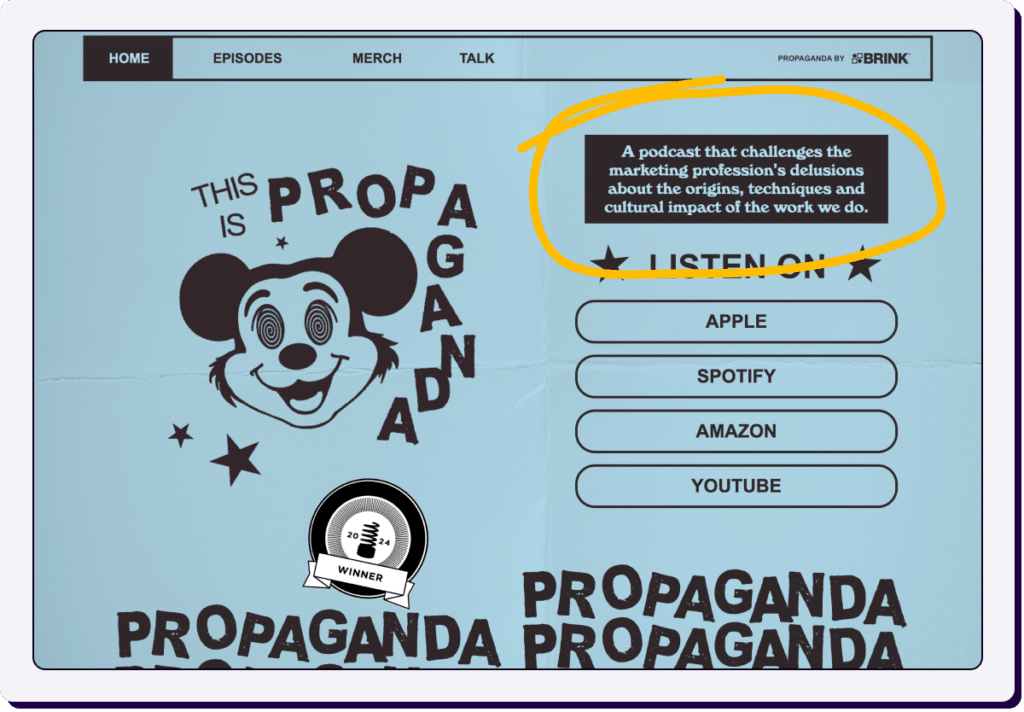“Small minds discuss people; average minds discuss events; great minds discuss ideas.”
The quote is most often attributed to Eleanor Roosevelt, but some version dates back to Socrates.
Clearly, the idea behind it has staying power.
It also has portability.
Because beyond applying to people, the sentiment highlights an important component of designing a marketable podcast:
The idea behind it.
See, while the vast majority of shows design, frame, and position their content around topics, the most memorable, resonant, and recommendable shows are built around ideas.
Specifically, great shows exist to explore and/or amplify one big controlling idea, with each episode playing a small but essential role in that mission.
A show’s controlling idea might be tied to the change the host or brand wants to see in the world.
Or, it might be a big question that the show will explore.
Or, it might be a specific idea that the host or brand wants to establish or reinforce an association with in the minds of their audience.
The best shows—and the best ideas—achieve all three.
Most shows lack a cogent controlling idea.
The result is flimsy, disposable, forgettable content that fails to stick with listeners or impact them beyond sharing a quick, surface-level tip here and there.
From the listeners’ perspective, these shows can certainly be helpful.
But they do next to nothing for the host in terms of building their business, audience, or authority.
Shows without a controlling idea tend to feel like a loose collection of episodes, floating around unbound by a central theme.
A listener might binge through these shows at 2x speed to transfer the desired knowledge as quickly and efficiently as possible… while failing to form any meaningful connection with the show, host, or brand.
Once they’ve got what they came for, they’re quick to discard the show and move on to the next thing, the show fading from memory within a few weeks.
Easy in, easy out.
As a listener, I’ve been through this cycle with dozens of shows, and have benefited from all of them.
As a creator, however, I want to create a richer, deeper, more durable connection with my audience.
I’m guessing you do to.
Which is where identifying the controlling idea behind your show comes in.
Your controlling idea is the frame that gives context to your episodes.
It gives your listeners a simple, specific hook to latch onto that differentiates you from your competition and makes you, your show, and your brand more distinct and memorable.
And it orients your audience around a common goal or belief with deeper emotional resonance than surface-level content about a topic.
Unlike a collection of topics, big ideas are durable, portable, easily communicable.
Most of all, they’re magnetic, attracting people, attention, and interest at a simple mention.
The bigger and more novel the idea, and the better you can articulate it, the more magnetic it is, and the more potential your show has for growth.
When you structure your show around a big idea, everything else—from content ideation, to guest & sponsor pitching, to sales, to marketing—becomes easier.
Finding and refining your idea is the hard part.
It’s the real work of brand building that most people gloss over.
Identifying and owning your big idea takes vision.
And courage.
It requires you to break from the crowd and chart a path that no one else in your space is taking—or perhaps even seeing.
It requires you to plant your flag, take a stand, and convincingly advocate for your idea in the face of opposition.
But it’s the key to creating a show that resonates deeply with your listeners, sticks with them after they stop listening, and perhaps most importantly, gets them talking about (and recommending) the show.
We’ll get into the specifics of what makes for a big idea in a moment, but first here are three examples of brands (and podcasts) built around big ideas.
80,000 Hours

The DO Lectures

This Is Propaganda

Brands have known the power of a big idea for ages.
Patagonia. Nike. Apple.
Each of these brands—and countless more—are in the business of selling ideas as much as they are selling products.
In fact, it’s the idea itself that often sells the product.
And the same dynamic applies to selling listeners on your podcast.
See, there’s an incredible amount of friction in selling someone on your show itself.
To buy, a listener must spend a significant amount of time (at least a few minutes, at most several hours) to sample a new show and assess if it will deliver what they’re looking for.
In a world where your listeners have podcast feeds already filled to the brim with shows they know, like, and trust to deliver, it’s a significant risk to spend their time trying something new.
And so it’s easier to stick with what they know.
A big idea on the other hand…
A big idea can captivate a listener in a matter of seconds.
And once it does, they’ll be compelled to listen to the show that embodies and explores that idea.
Because while decent content is ubiquitous, big ideas are rare.
And as consumers, we’ll pay a premium for them, moving the shows that revolve around and explore them to the top of our feeds, following the hosts on every platform we can find, and eventually, perhaps even signing up to work with them—where we’ll then happily pay above market rate.
Elements of a big idea to build your podcast around.
While every big idea is different, they tend to be built around several of the following traits:
Progressive – Not in the political sense, but in that they build on the existing knowledge and ideas of their space and add something new. They are not simply rehashing old ideas.
Example: I Will Teach You To Be Rich — Personal finance advice is everywhere, but no one is talking about couples’ financial advice, whose approach to money has major ramifications on both their relationship and their finances
Timely – Taps into the current zeitgeist and/or trends. Is highly relevant and perhaps even urgent.
Example: Wiser Than Me — Older women are often relegated to the background, but they have a wealth of wisdom to share. Especially relevant now as the Baby Boomer and Gen X generations—the first two generations where women played a more prominent role in the work force, politics, and society—are aging out of the workforce.
Refreshing – Usually by proposing a novel, non-obvious solution to a known, perplexing problem.
Example: Acquired — Instead of softball CEO interviews, what if you approached a business podcast like Dan Carlin approaches history?
Subversive – Challenges conventional wisdom, sentiment, and rhetoric in its space.
Example: How Stories Happen — Storytelling is not an innate talent. Great stories happen to those who can tell them. And anyone can learn to tell them.
Raises the Stakes or Expectations – Suggests that more is possible than people previously thought… and calls them to action.
Example: Billion Dollar Creator — Is it possible to build a billion-dollar creator business? And if so, how?
Specific – The idea—including the status quo, problem, proposed solution, and (bad) alternatives—has been thoroughly defined and mapped out.
Example: 80,000 Hours — We spend 80,000 hours working. Which means our careers are the greatest lever we have to make an impact. We’ve done all the research to help you maximize the impact you make in your career.
Simple – Can be understood by the intended audience easily without much (if any) additional context, background, or explanation.
Example: You’re Wrong About — The media often gets pop-culture phenomena wrong, especially those involving women.
Well Articulated– Can be encapsulated in a clear, concise, punchy way that makes it memorable and easy for others to share.
Example: Freakonomics — Exploring the hidden side of everything.
Opinionated – Takes a stand and proposes a direction that others can (and will) disagree with.
Example: Everyone Hates Marketers — Another trendy marketing tactic won’t help you, building a personal brand that stands the f*ck out will.
Your big idea is the foundation of your show.
It guides your content strategy and can provide a powerful hook for listeners.
But it’s format-agnostic.
There are many (perhaps infinite) ways you could construct a show around any one idea. How you choose to use your show to explore or amplify your big idea is up to you.
Some shows, like 3 Books use every episode as an direct vehicle to explore the big idea (uncovering the 1,000 most formative books in the world).
Others, like On Being, allow the big idea (what does it mean to be a human alive in the world today?) to hover in the background as subtext, always present but rarely addressed directly.
Regardless of which method you employ, the show itself should be useful, enjoyable, or entertaining. It must do a tangible job for listeners.
Because while a big idea can be a vehicle for a podcast, the podcast is also a vehicle for the idea.
Many big idea shows lean too heavily on the idea, failing to wrap it in a compelling show concept that makes for an engaging listener experience. The result is a show that feels academic, preachy… and often self-serving.
No matter how important the idea, no one wants to listen to that.
To find the root of your big idea, start with the following prompts:
- What specific change do you want to see in your space?
- What question or hunch do you have about a problem in your space that you can follow and explore?
- What idea, feeling, or sentiment do you want to be associated with you and your brand?
Any of these questions can uncover the ore that will form your big idea.
That’s the beginning.
Then comes the work of excavating, pressure testing, and polishing it into something that catches your listeners’ eyes and draws them in.
It’s not easy.
But if you want to grow, it’s the hard work worth doing.





